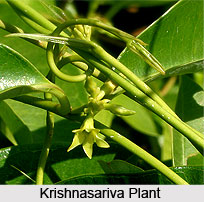 Krishnasariva is an Indian medicinal plant that are scattered throughout the central and southern parts of India. They mainly grow in dry localities, in deciduous forests and in hedges. The botanical name of Krishnasariva plant is Cryptolepis reticulata. The common names of the plant vary according to the Indian regions. For instance in Hindi Krishnasariva is known as Dudhi, Kali dudhi, and Karanta; in Kannada it is named Metaguli hambu; in Marathi it is popularly known as Kaovel, and Kawavel; in Oriya it is famous as Gopikonioro and Maloti; and in Sanskrit it is known as Krishnasariva.
Krishnasariva is an Indian medicinal plant that are scattered throughout the central and southern parts of India. They mainly grow in dry localities, in deciduous forests and in hedges. The botanical name of Krishnasariva plant is Cryptolepis reticulata. The common names of the plant vary according to the Indian regions. For instance in Hindi Krishnasariva is known as Dudhi, Kali dudhi, and Karanta; in Kannada it is named Metaguli hambu; in Marathi it is popularly known as Kaovel, and Kawavel; in Oriya it is famous as Gopikonioro and Maloti; and in Sanskrit it is known as Krishnasariva.
Morphology of Krishnasariva
Krishnasariva plants are large evergreen climbing shrubs. Leaves of this Indian medicinal plant are opposite, elliptic-oblong and are 5 to 18 centimetres long. These are 2.5 to 8 centimetres wide and have rounded base. Krishnasariva plant bears greenish-yellow coloured flowers. The flowers are shorter than leaves and usually of 1.2 to 2 centimetres in diameter. The fruits of this plant are generally known as follicles. These are 5 to 10 centimetres long, green coloured straight fruits.
Medicinal Use of Krishnasariva
Krishnasariva plants are used for medicinal purpose throughout the country. The root is used for the treatment of polyuria, haemorrhage, gout, wounds, leprosy, anaemia and jaundice. It is also considered as alterative, aphrodisiac, refrigerant, diuretic and tonic. In some parts of India, the root of this medicinal plant is crushed with Cassia fistula and is used as antinarcotics to revive the nervous system paralysed by alcoholic intoxication. Similarly several inhabitants use the filtered extract of the pounded roots internally to relieve stomach pain. The leaves are toxic, so a special care is needed.
This article is a stub. You can enrich by adding more information to it. Send your Write Up to content@indianetzone.com



















